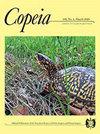The Effects of Common Snapping Turtles on a Freshwater Food Web
IF 2.6
Q2 Agricultural and Biological Sciences
引用次数: 5
Abstract
While organisms are typically considered permanent residents of a community, many transient organisms occupy a community for only brief periods. Despite the duration, the effects of a short visit by a top predator may remain long after departure. To test hypotheses on the impacts of a short-term visit by a top predator on pond communities, we used artificial ponds and constructed food web treatments that varied in trophic structure (Control Food Web = no predators present, Bluegill Food Web = only intermediate predators present, and Full Food Web = top and intermediate predators present). The constructed food webs were replicated five times and contained two prey species (frog tadpoles), an intermediate predator (fish), and one top predator (freshwater turtle). The Full Food Web simulated a four-day visit by Chelydra serpentina (Common Snapping Turtle). Predation by Lepomis macrochirus (Bluegill) reduced mean tadpole survival for Hyla chrysoscelis (Cope's Gray Tree Frog) in all food webs, including the Full Food Web with C. serpentina, compared to the Control Food Web. Although C. serpentina had no effects on tadpoles of H. chrysoscelis, the top predator reduced mean survival and increased mean mass of Rana sphenocephala (Southern Leopard Frog) when compared to the Bluegill Food Web. Therefore, our results suggest that brief visits from transient organisms, especially top predators, can alter community structure and initiate cascading effects.普通鳄龟对淡水食物网的影响
虽然生物通常被认为是一个群落的永久居民,但许多短暂的生物只在一个群落中短暂居住。尽管持续时间很长,但顶级掠食者短暂造访的影响可能在离开后很长时间内仍然存在。为了验证顶级捕食者短期造访对池塘群落影响的假设,我们使用了人工池塘,并构建了不同营养结构的食物网处理方法(控制食物网=没有捕食者,蓝鳃鱼食物网=只有中间捕食者,完整食物网=存在顶级和中间捕食者)。构建的食物网被复制了五次,包含两种猎物(青蛙蝌蚪),一种中间捕食者(鱼)和一种顶级捕食者(淡水龟)。全食物网模拟了Chelydra serpentina(普通鳄龟)为期四天的访问。与控制食物网相比,蓝鳃蓝鳃蛙(Lepomis macrochirus, Bluegill)的捕食减少了Hyla chrysoscelis (Cope’s Gray Tree Frog,灰树蛙)在所有食物网中的平均蝌蚪存活率,包括含有c.s serpentina的完整食物网。与蓝鳃鱼食物网相比,蛇纹蛙降低了南豹蛙(Rana sphenocephala)的平均存活率,增加了南豹蛙(Rana sphenocephala)的平均质量。因此,我们的研究结果表明,来自瞬时生物,特别是顶级捕食者的短暂访问可以改变群落结构并引发级联效应。
本文章由计算机程序翻译,如有差异,请以英文原文为准。
求助全文
约1分钟内获得全文
求助全文
来源期刊

Copeia
生物-动物学
CiteScore
2.10
自引率
0.00%
发文量
0
审稿时长
6-12 weeks
期刊介绍:
Founded in 1913, Copeia is a highly respected international journal dedicated to the publication of high quality, original research papers on the behavior, conservation, ecology, genetics, morphology, evolution, physiology, systematics and taxonomy of extant and extinct fishes, amphibians, and reptiles. Copeia is published electronically and is available through BioOne. Articles are published online first, and print issues appear four times per year. In addition to research articles, Copeia publishes invited review papers, book reviews, and compiles virtual issues on topics of interest drawn from papers previously published in the journal.
 求助内容:
求助内容: 应助结果提醒方式:
应助结果提醒方式:


